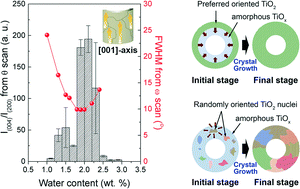Observation of anatase nanograins crystallizing from anodic amorphous TiO2 nanotubes†
Abstract
A mechanism underlying the appearance of a preferred orientation in anodized amorphous TiO2 nanotube arrays (NTAs) was studied. Transmission electron microscopic analyses of preferred-oriented nanotube arrays (p-NTAs) reveal that at an optimum water content (~2 wt%), large single crystalline domains oriented along <001> grow from the outer wall to the inner wall to minimize the surface energy. In stark contrast, excessive water content (5 wt%) in the electrolyte leads to sporadic multiple nucleation of randomly oriented anatase crystallites in amorphous medium at the early stage of crystallization, which results in the formation of randomly oriented nanotube arrays (r-NTAs). During subsequent thermal annealing, multiple nucleation sites hindered the growth of the <001>-oriented grains from the outer wall. When the water content in an ethylene glycol-based electrolyte is optimized by reducing the uncertainty of water content, the X-ray diffraction patterns of NTAs exhibited a 200 times increase in the intensity ratio of (004) to (200) peaks of the anatase phase. p-NTAs exhibit ~5 times lower electrical resistance than r-NTAs, which supports the idea that improving the preferred orientation of NTAs is a promising method for developing efficient electronic devices.


 Please wait while we load your content...
Please wait while we load your content...